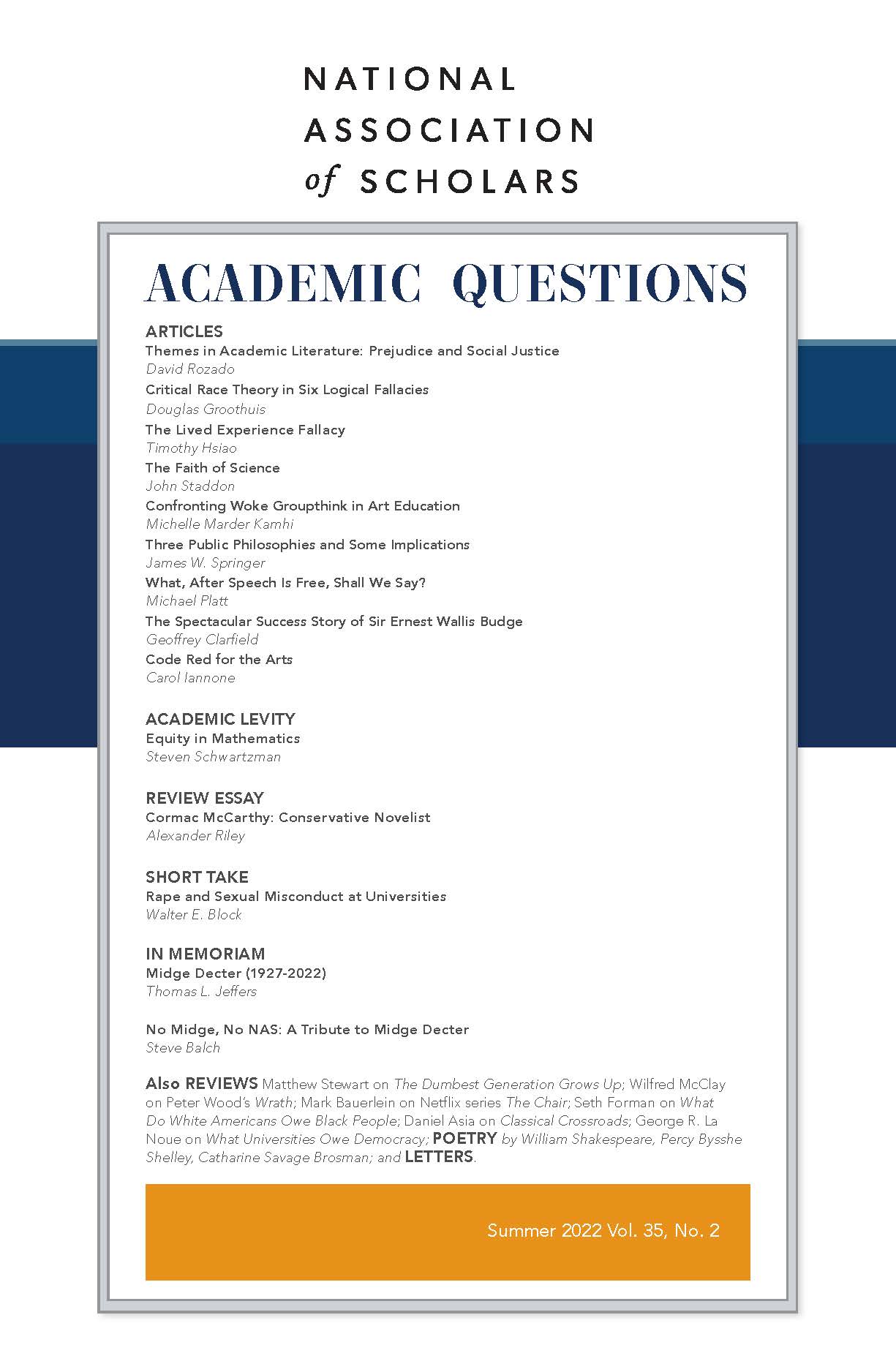The Dumbest Generation Grows Up: From Stupefied Youth to Dangerous Adults, Mark Bauerlein, Regnery Gateway, 2022, pp. 310, $29.99, hardbound.
Matthew Stewart is associate professor of humanities and rhetoric at Boston University and the author of Modernism and Tradition in Ernest Hemingway’s In Our Time (2009); [email protected]. His last review essay for Academic Questions, “The Meaning of Diversity,” appeared in the Spring 2021 issue.
In his 2008 book The Dumbest Generation, Mark Bauerlein devoted a chapter to “The Betrayal of the Mentors.” If then-teenaged millennials spent way too much time on shallow and trivializing pursuits, their elders—teachers and professors lamentably included along with parents—bore a fair share of the blame. Screen time was already way up even though the smart phone age was merely dawning. Book reading was way down. Technophiles and edutopians touted the enormous benefits that online classrooms and wired education would bring. The major worry was that those on the wrong side of the “digital divide”—the poor, the geographically marginalized—would fall behind.
Did the mentors push back? Did they defend the printed page, exerting themselves to make books attractive to the young? Did they entertain the possibility that there was a cause-effect relationship between increased screen time and decreased literacy? (Perhaps they could be forgiven their failure in those early 2.0 days to associate 24-7 connectedness with the reportedly soaring rates of anxiety and depression amongst those under thirty.) Did they stoutly defend the cultural achievements that went hand-in-hand with a print-literate culture? Did it occur to them that teenagers spending ever increasing hours with exclusively teenage stuff and exclusively intra-teen socialization might come with an opportunity cost in maturation? Or did they jump on the tech bandwagon, eager to align themselves with the latest trends while staying cool (so they thought) in the eyes of the young? With good reason, Bauerlein found the authorities wanting in 2008. Now in his second installment, The Dumbest Generation Grows Up, he concludes that now-adult millennials are in part “victims of an older generation of mentors who didn’t know how to be mentors—and still don’t. The authorities who ought to be . . . the stewards of tradition don’t define themselves that way, and so they have little to offer the young” (246).
The screen world presents so many easily-taken avenues for instant gratification and adolescent self-expression, leaving little time for the hilly roads to self-formation still out there in the real world. Fourteen years later the script has flipped on the “digital divide.” It never materialized. But the educational divide remains as evident as ever. Poor children and young adults now spend more time with their screens than do their more affluent peers, whose parents have taken notice that Tik-Tok and Fortnite are impediments to academic achievement and upward mobility. Drawing on reportage by Nellie Bowles at the New York Times, Bauerlein recounts the Silicon Valley seminars crowded with techno-savvy parents hoping to learn how to steer their children away from the hazards of online life and digital schooling. Erstwhile editor of Wired magazine Chris Anderson compared the inventions so fervently championed by that very magazine to crack cocaine: “This is going straight to the pleasure centers of the developing brain. This is beyond our capacity as regular parents to understand.” (11) The tech entrepreneur Nir Eyal has found a way to play both sides, first authoring the book Hooked: How to Build Habit-Forming Products (2014), then later, Indistractable: How to Control Your Attention and Choose Your Life (2019).
Despite the implications of his inflammatory title, then, Bauerlein argues that millennials are not entirely to blame for their arrested development. Even so, the word dumbest doesn’t seem quite right, for native intelligence surely must be distributed as ever. That intelligence has not been cultivated, however, nor the spirit strengthened. Few tweens and teens could be expected to resist the cultivation of their newest me, or forego peer-to-peer texting, photo-swapping, game-playing and all manner of socializing made so readily available by electronic enticements. While age-appropriate, such socializing was never before so constant, never so saturated. Nor was it mediated by screen technologies, most of which are proprietary. The opportunity costs are immense, and while some parents have caught on in principle, the pixelated path of least resistance always beckons. And teachers, who ought to have maintained a line of resistance, have often played the shill for tech companies. Over and over Bauerlein has heard from them that he is a fuddy-duddy, kids have a different way of learning now, and don’t you know that you can always look it up. But some teachers do note that despite having been awash in information for their entire digital-native lives, many young adults know surprisingly little.
Nor do they have insight into the ways of the world or the exigencies of adult life, their hermetic teenage years having robbed them of perspective. “Millennials grew up in a world of their own,” Bauerlein writes, “and it didn’t provide them with the tools to handle the ordinary pains of life once they had to leave that world.” (35) While he does not frequently discuss Gen-Zers as a distinct cohort—those who have entered the nation’s classrooms in the interval between his two books—his observations clearly apply to many of them as well. Thus the election of Donald Trump wasn’t merely a stunning political setback to their causes, but in their minds it was an unprecedented calamity. The word existential was set to come into frequent play, one of the tropes and verbal tics used by a generation prone to catastrophize ordinary upsets and hyperbolize mundane discomfort. Even before Trump’s election, the mere sight of his name in public sent students at Bauerlein’s own campus (Emory University) running to the president, who followed the now-expected script by publicly acknowledging their “pain.” A cherry-picked sample of student behavior, with the meetings of the Marcus Aurelius club ignored and left unreported? One can only say that a lot of cherries have presented themselves for picking, and Bauerlein’s bushel basket fills up.
We can recognize the hard knocks experienced by the millennial generation—the 2008 financial crisis, the exploding cost of higher education, the educational fads they were subjected to—while also observing that their public voices are prone to pluck the chords of self-pity while placing the blame for their woes elsewhere. Not for them the Hemingway credo, “If you’re any good, everything is your own fault.” They are not only unhappy, Bauerlein tells us; they are dangerous. The millennial version of what ought to be has not been tempered by religious training, the development of an historical imagination, or sufficient talk with mature elders, and it is therefore utopian. “Digital tools and lax mentors primed them to flee from history, religion, great literature, and art, from music and ethics and American civics, into the fantasy of a society” that would match their childish idealism and expectations of instant results. Ordinary growing up was not just ordinarily difficult for millennials but painful and confusing. The opportunity costs came home to roost for a generation that had “no religion, no cultural patrimony, and no role models to ease the transition” into adult life. (46) Because their high-profile causes are utopian, they are unachievable (“social justice” rather than justice), often not even within the bounds of common sense (“defund the police”).
Utterance, performance, meme: these words seem to capture the relationship between all but the most activist of millennials and their various desiderata. Goals to be worked for and realized over the long haul . . . not so much. Social media “likes” are easily confused with achievable and achieved social change by the weak minded. Here we are on one of Bauerlein’s most important themes: the ascendance of emotionalism over rationalism. Millennials have arrived at their utopian attitudes “not by the process of study and reason, but by the opposite, for emotional and psychological reasons.” (46) In the last chapter, Bauerlein invites the reader to contrast Malcolm X with leading millennial politicians such as Alexandria Ocasio-Cortez. While disagreeing with the politics of both, he finds the poise and depth of Malcolm in stark contrast to the veneer intelligence of the Twitter generation. Malcolm’s intellect was a product of deliberate self-making, cultivated through assiduous reading and study during his imprisonment. Ocasio-Cortez, apparently bright enough, nonetheless has yawning gaps of knowledge and obvious deficiencies of intellectual resource. In short, she was not properly taught or properly mentored, and being a product of her own time and unlike Malcolm, she has neither the humility nor perspective to realize this fact, and therefore no drive to rectify it.
Bauerlein is a learned and beguiling writer, and one nods in agreement page after page, analysis after analysis, example after example. But stepping back outside the book’s close argumentation, one ponders the degree to which a generational cohort can be generalized. And even if some generalizations are valid, of what use are they in understanding individual men and women? On the one hand the descriptions of millennials offered here will be acknowledged by readers of Academic Questions, who have encountered such stuff in their classrooms and offices. The lack of reading really shows, and the growing number of students who don’t seem to recognize that lack as a problem is even more remarkable. So is the lack of concern over developing adult tastes. For a significant number of twenty-somethings, Disney not only remains their cultural touchstone, but they seem content to keep it that way. There has been a turn towards emotionalism, some of it downright narcissistic, and a resistance to rationality or even plain fact in the face of the merely emotional. I could go on. But—again—to what percentage of the generation do these undesirable traits apply, and what percentage would need to be reached before we can declare the generalization to be valid?
Surely the characterization will also be recognized by those working in other professional sectors. My own one-man sample of conversations with those outside the academy has turned up the same negative characterizations: needy, whiny, demanding, entitled, fragile. (As a side note, the English teacher in me also notes hearing the complaint “they can’t write.”) But I would like to know to what degree negativity bias is in play here, so that managers are attributing the annoying characteristics of their most immature underlings and co-workers to an entire generation. When asked to characterize, perhaps one pain-in-the-ass young employee leaps to their minds, while half a dozen who don’t fit the negative description fail to enter the picture. I should also note that in every case the cohort being described is actually a small subset of the millennial generation, the subset consisting of college graduates, almost exclusively from high-profile institutions. Thus the paradox (or is it a dilemma?) of studies of generational cohorts: good ones—and Dumbest Generation is very much one of these—do land upon general truths and describe real trends. And yet there are more than a few within the cohort to whom the generational description does not apply, or applies only partially, lightly. There are actually many whose characters do not conform to the generational description.
To step away from these general considerations and back into the book, it would be a negligent reviewer who failed to note Bauerlein’s authority on educational trends and practices and his sound judgment of what works educationally and what doesn’t. His wide learning in the arts and humanities furnishes the pages with interesting comparisons, counterpoints, and analyses. His championing of the print medium in general and old books in particular is welcome in an age that gives in far too often to heedless iconoclasm and self-satisfied presentism. When it looks up from underlining the book’s many quotable passages, the readership of this journal will want to ask itself what it can do to conserve the culture and mentor its youth.
Image: Eddi Aguirre, Public Domain













